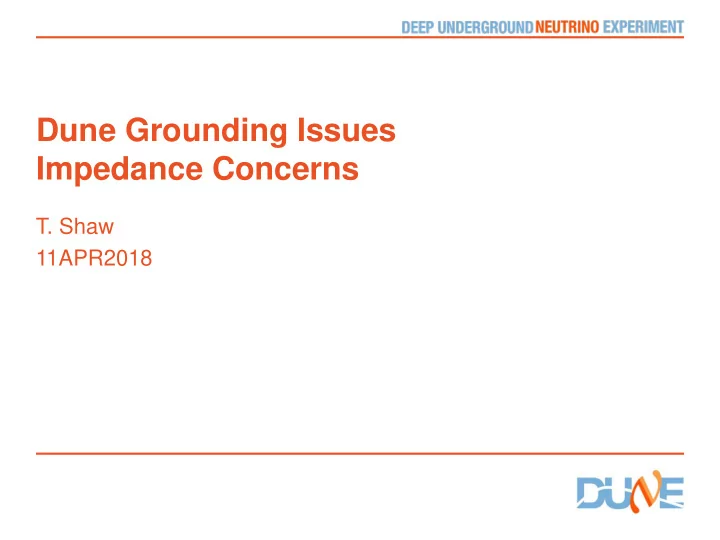

Dune Grounding Issues Impedance Concerns T. Shaw 11APR2018
Grounding Plan • Grounding Plan can be found in DUNE docdb 285 https://docs.dunescience.org:440/cgi- bin/ShowDocument?docid=285 • Need to consider the resistivity of concrete slab. 2 10APR2018 Cryostat Slab and final design
Electronics Low Noise Design • What are we trying to address? • The noise level at the front end electronics is measured in electrons. We expect on order of 500 electrons rms noise. • I = ∆Q/∆t = (500 e- x 1 Coulomb / 6.242 x 10 18 e-) / 500 x 10 -9 seconds • = 160 picoamps • We need to make sure the front end electronics see a contribution much less than 160 picoamps from any infrastructure ground noise. 3 10APR2018 Cryostat Slab and final design
Detector Ground Isolation 4 10APR2018 Cryostat Slab and final design
Cryostat Construction • At ProtoDUNE, the cryostat sits on a thin G10 insulator to make a DC break with the building concrete with “building” rebar • At DUNE, the cryostat sits on concrete pad which should not have conductive reinforcement, a gravel bed and then stone. • NOTE: non-conductive reinforcement is required to lower capacitive coupling between “earth” and “detector” grounds. Old picture ; before our grounding rules 5 10APR2018 Cryostat Slab and final design
Cryostat Construction/Installation 6 10APR2018 Cryostat Slab and final design
Grounding Concerns • Ideally the resistance between “detector” ground and the “Cavern/building” ground should be >10 ohms. Resistance must be much greater than the resistance of our “safety ground” (saturable inductor). • If we provide proper low impedance connections to the equipment located on each of the two ground structures, this will help reduce stray currents from flowing between the two “isolated” systems and reduce noise. • NOTE: We must pay attention to and approve the building services and cryo connections as well as the detector connections. Of particular concerns are any pumps and VFD controllers that can radiate noise. 7 10APR2018 Cryostat Slab and final design
Getting to “10 ohms” btw grounds • Problem – resistivity of concrete needs to be taken into account • If we take the below slice as our model, we need the concrete slab to provide us with the 10 ohms resistance. 8 10APR2018 Cryostat Slab and final design
Resistivity of concrete 9 10APR2018 Cryostat Slab and final design
Resistivity of concrete Conclusions: Concrete does not • give us the resistance we seek • A thin isolator between the cryostat and the concrete, such as G10 or some epoxy resin, does 10 10APR2018 Cryostat Slab and final design
Construction • We should plan to incorporate a thin piece of G10 on the beam bottoms. • Could consider use an epoxy grout with high resistivity during construction 11 10APR2018 Cryostat Slab and final design
Current Grounding Conceptual Drawing 12 10APR2018 Cryostat Slab and final design
Proposed Grounding Conceptual Drawing – with Rock Septum 13 10APR2018 Cryostat Slab and final design
Backup • 15 10APR2018 Cryostat Slab and final design
Capacitance 16 10APR2018 Cryostat Slab and final design
Recommend
More recommend